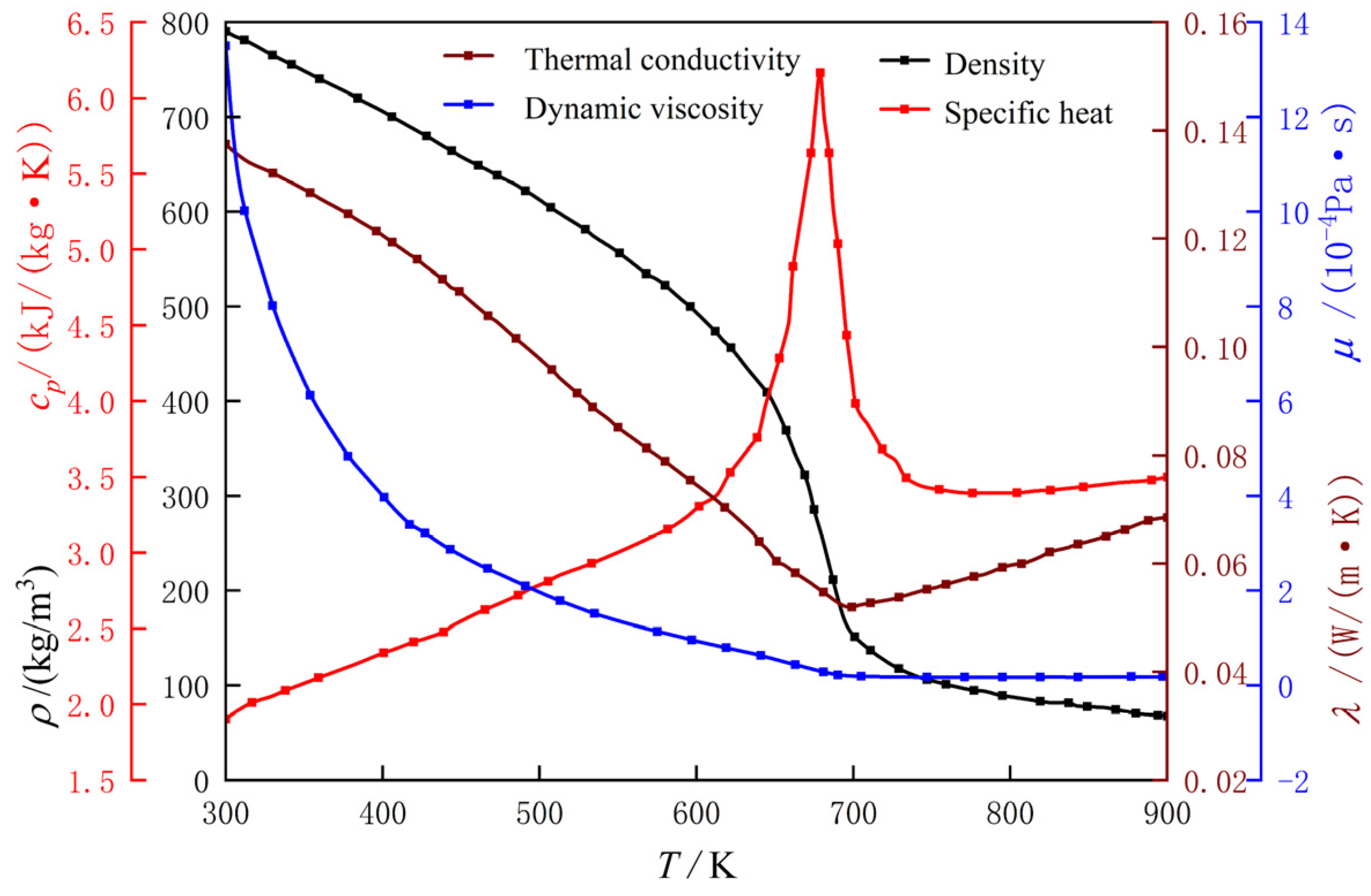Convection Heat-Transfer Characteristics of Supercritical Pressure RP-3 in Horizontal Microchannels
Abstract
1. Introduction
2. Experiment Section
2.1. Experiment System
2.2. Data Reduction
3. Numerical Methods
3.1. Physical Model
3.2. Thermophysical Property
3.3. Computational Model
3.4. Data Analysis
3.5. Grid Independence and Model Validation
4. Result and Discussion
4.1. Analysis of Heat-Transfer Mechanism
4.2. Effect of Mass Flux
4.3. Effect of Inlet Temperature
4.4. Effect of Gravitational Acceleration
4.5. Evaluation of Buoyancy Criterion Number
5. Conclusions
- The convective heat-transfer process of supercritical RP-3 within a horizontal circular tube can be divided into five stages: the heating entrance segment, the normal heat-transfer segment, the heat-transfer deterioration segment, the heat-transfer enhancement segment, and the high-temperature normal heat-transfer segment. The sharp rise in temperature in the heating entrance segment is primarily associated with the development of the thermal boundary layer. Within the heat-transfer deterioration segment, two instances of heat-transfer deterioration occur, primarily due to the dual effects of thermal properties and buoyancy. As the bulk temperature approaches the pseudo-critical temperature, the tube enters the heat-transfer enhancement stage;
- The action of buoyancy induces secondary flow phenomena, which in turn, leads to a deterioration of heat transfer on the upper wall and enhancement on the lower wall. Higher mass flux alleviates the effects of buoyancy, whereas supercritical states intensify these effects. Meanwhile, the inlet temperature does not influence the heat-transfer process;
- Buoyancy impacts the heat-transfer processes differently in vertical and horizontal tubes, and their respective dimensionless numbers should not be used interchangeably. Among the four types of buoyancy criterion numbers, Grq/Grth provides the most accurate prediction of buoyancy effects within horizontal circular tubes and is capable of distinguishing the subtle differences between the two instances of heat-transfer deterioration.
Author Contributions
Funding
Data Availability Statement
Conflicts of Interest
Nomenclature
| Bo* | buoyancy number |
| BuJ | buoyancy number |
| cp | specific heat, kJ/(kg·K) |
| d | diameter, m |
| g | gravitational acceleration, m/s2 |
| G | mass flux, kg/(m2·s) |
| Gr, Grq, Grth | Grashof number |
| H | enthalpy, kJ/kg |
| I | electrical current, A |
| h | HTC, kW/(m2·K) |
| k | turbulent kinetic energy, m2/s2 |
| L | length, mm |
| M | measured value |
| m | mass flow rate, g/s |
| Pr | Prandtl number |
| q | heat flux, W/m2 |
| Re | Reynolds number |
| T | temperature, °C |
| U | voltage, V |
| u | velocity, m/s |
| x, y, z | x, y, z directions, mm |
| y+ | radial dimensionless distance |
| Greek symbols | |
| β | thermal expansion coefficient, 1/K |
| δ | Wall thickness, m |
| η | thermal efficiency, % |
| μ | viscosity, Pa·s |
| λ | thermal conductivity, W/(m·K) |
| ρ | density, kg/m3 |
| ν | kinetic viscosity, m2/s |
| ω | specific dissipation rate, s−1 |
| Subscripts | |
| b | bulk fluid |
| Bottom | bottom wall |
| cal | calculated |
| exp | experimental |
| in | inlet, inner |
| out | outlet, outer |
| PC | pseudo critical |
| t | turbulent |
| Top | top wall |
| w | wall |
| y | y direction |
| Abbreviation | |
| CFD | computational fluid dynamics |
| SST | shear-stress transport |
References
- Bao, W.; Li, X.L.; Qin, J.; Zhou, W.X.; Yu, D.R. Efficient utilization of heat sink of hydrocarbon fuel for regeneratively cooled scramjet. Appl. Therm. Eng. 2012, 33–34, 208–218. [Google Scholar] [CrossRef]
- Qin, J.; Zhang, S.L.; Bao, W.; Zhou, W.X.; Yu, D.R. Thermal management method of fuel in advanced aeroengines. Energy 2013, 49, 459–468. [Google Scholar] [CrossRef]
- Huang, D.; Wu, Z.; Sunden, B.; Li, W. A brief review on convection heat transfer of fluids at supercritical pressures in tubes and the recent progress. Appl. Energy 2016, 162, 494–505. [Google Scholar] [CrossRef]
- Han, H.B.; Wang, R.T.; Bao, Z.W. Effect of secondary flow and secondary reactions on pyrolysis and heat transfer of supercritical hydrocarbon aviation fuel in a u-bend tube. Energy 2024, 292, 130518. [Google Scholar] [CrossRef]
- Zhu, J.Q.; Tao, K.H.; Tao, Z.; Qiu, L. Heat transfer degradation of buoyancy involved convective rp-3 hydrocarbon fuel in vertical tubes with various diameters under supercritical pressure. Appl. Therm. Eng. 2019, 163, 114392. [Google Scholar] [CrossRef]
- Li, S.F.; Wang, Y.N.; Dong, M.; Pu, H.; Jiao, S.; Shang, Y. Experimental investigation on flow and heat transfer instabilities of rp-3 aviation kerosene in a vertical miniature tube under supercritical pressures. Appl. Therm. Eng. 2019, 149, 73–84. [Google Scholar] [CrossRef]
- Raisee, M.; Vahedi, N.; Rostamzadeh, A. Prediction of Gas Flow Through Short and Long 2-D Micro and Nano-Channels Using a Generalized Slip Model. In Proceedings of the Sixth International ASME Conference on Nanochannels, Microchannels, and Minichannels, Darmstadt, Germany, 23–25 June 2008; pp. 103–109. [Google Scholar]
- Rahbarshahlan, S.; Esmaeilzadeh; Khosroshahi, R.; Bakhshayesh, G.A. Numerical simulation of fluid flow and heat transfer in microchannels with patterns of hydrophobic/hydrophilic walls. Eur. Phys. J. Plus 2020, 135, 157. [Google Scholar] [CrossRef]
- Zhang, C.B.; Xu, G.Q.; Gao, L.; Tao, Z.; Deng, H.W.; Zhu, K. Experimental investigation on heat transfer of a specific fuel (rp-3) flows through downward tubes at supercritical pressure. J. Supercrit. Fluids 2012, 72, 90–99. [Google Scholar] [CrossRef]
- Ren, Y.Z.; Zhu, J.Q.; Deng, H.W. Numerical study of heat transfer of rp-3 at supercritical pressure. Adv. Mater. Res. 2013, 663, 470–476. [Google Scholar] [CrossRef]
- Wang, H.; Zhou, J.; Pan, Y.; Wang, N. Experimental investigation on the onset of thermo-acoustic instability of supercritical hydrocarbon fuel flowing in a small-scale channel. Acta Astronaut. 2015, 117, 296–304. [Google Scholar] [CrossRef]
- Huang, D.; Ruan, B.; Wu, X.Y.; Zhang, W.; Xu, G.Q.; Tao, Z.; Jiang, P.X.; Ma, L.X.; Li, W. Experimental study on heat transfer of aviation kerosene in a vertical upward tube at supercritical pressures. Chin. J. Chem. Eng. 2015, 23, 425–434. [Google Scholar] [CrossRef]
- Yoo, J.Y. The turbulent flows of supercritical fluids with heat transfer. Annu. Rev. Fluid Mech. 2013, 45, 495–525. [Google Scholar] [CrossRef]
- Wang, H.; Leung, L.K.H.; Wang, W.S.; Bi, Q.C. A review on recent heat transfer studies to supercritical pressure water in channels. Appl. Therm. Eng. 2018, 142, 573–596. [Google Scholar] [CrossRef]
- Chen, Y.Q.; Li, Y.; Sunden, B.; Xie, G.N. The abnormal heat transfer behavior of supercritical n-decane flowing in a horizontal tube under regenerative cooling for scramjet engines. Appl. Therm. Eng. 2020, 167, 114637. [Google Scholar] [CrossRef]
- Sun, X.; Xu, K.; Meng, H.; Zheng, Y. Buoyancy effects on supercritical-pressure conjugate heat transfer of aviation kerosene in horizontal tubes. J. Supercrit. Fluids 2018, 139, 105–113. [Google Scholar] [CrossRef]
- Pidaparti, S.R.; Mcfarland, J.A.; Mikhaeil, M.M.; Anderson, M.H.; Ranjan, D. Investigation of buoyancy effects on heat transfer characteristics of supercritical carbon dioxide in heating mode. J. Nucl. Eng. Radiat. Sci. 2015, 1, 031001. [Google Scholar] [CrossRef]
- Tanimizu, K.; Sadr, R. Experimental investigation of buoyancy effects on convection heat transfer of supercritical co2 flow in a horizontal tube. Heat Mass Transf. 2016, 52, 713–726. [Google Scholar] [CrossRef]
- Sun, F.; Li, Y.; Manca, O.; Xie, G.N. An evaluation on the laminar effect of buoyancy-driven supercritical hydrocarbon fuel flow and heat transfer characteristics. Int. J. Heat Mass Transf. 2019, 142, 118414. [Google Scholar] [CrossRef]
- Hou, J.R.; Zhou, Y.; Yuan, Y.; Huang, S.F. Numerical study on flow structure and heat transfer of supercritical co2 in tubes with different inclination angles. Prog. Nucl. Energy 2024, 168, 105028. [Google Scholar] [CrossRef]
- Fu, Y.C.; Huang, H.R.; Wen, J.; Xu, G.Q.; Zhao, W. Experimental investigation on convective heat transfer of supercritical rp-3 in vertical miniature tubes with various diameters. Int. J. Heat Mass Transf. 2017, 112, 814–824. [Google Scholar] [CrossRef]
- Cheng, L.Y.; Xu, J.L.; Cao, W.X.; Zhou, K.P.; Liu, G.L. Supercritical carbon dioxide heat transfer in horizontal tube based on the froude number analysis. Energy 2024, 294, 130980. [Google Scholar] [CrossRef]
- Li, Y.; Sun, F.; Sunden, B.; Xie, G.N. Turbulent heat transfer characteristics of supercritical n-decane in a vertical tube under various operating pressures. Int. J. Energy Res. 2019, 43, 4652–4669. [Google Scholar] [CrossRef]
- Adebiyi, G.A.; Hall, W.B. Experimental investigation of heat transfer to supercritical pressure carbon dioxide in a horizontal pipe. Int. J. Heat Mass Transf. 1976, 19, 715–720. [Google Scholar] [CrossRef]
- Pu, H.; Li, S.F.; Dong, M.; Jiao, S.; Wang, Y.; Shang, Y. Convective heat transfer and flow resistance characteristics of supercritical pressure hydrocarbon fuel in a horizontal rectangular mini-channel. Exp. Therm. Fluid Sci. 2019, 108, 39–53. [Google Scholar] [CrossRef]
- Petukhov, B.S.; Polyakov, A.F.; Kuleshov, V.A.; Sheckter, Y.L. Turbulent flow and heat transfer in horizontal tubes with substantial influence of thermogravitational forces. In International Heat Transfer Conference Digital Library; Begel House Inc.: Danbury, CT, USA, 1974. [Google Scholar]
- Tian, R.; Wang, D.B.; Zhang, Y.; Ma, Y.Z.; Li, H.; Shi, L. Experimental study of the heat transfer characteristics of supercritical pressure r134a in a horizontal tube. Exp. Therm. Fluid Sci. 2019, 100, 49–61. [Google Scholar] [CrossRef]
- Deng, H.W.; Zhang, C.B.; Xu, G.Q.; Tao, Z.; Zhu, K.; Wang, Y.J. Visualization experiments of a specific fuel flow through quartz-glass tubes under both sub- and supercritical conditions. Chin. J. Aeronaut. 2012, 25, 372–380. [Google Scholar] [CrossRef]
- Zhang, C.B.; Deng, H.W.; Xu, G.Q.; Huang, W.; Zhu, K. Enthalpy measurement and heat transfer investigation of rp-3 kerosene at supercritical pressure. J. Aerosp. Power 2010, 25, 331–335. [Google Scholar]
- Deng, H.W.; Zhu, K.; Xu, G.Q.; Tao, Z.; Zhang, C.B.; Liu, G.Z. Isobaric specific heat capacity measurement for kerosene rp-3 in the near-critical and supercritical regions. J. Chem. Eng. Data 2012, 57, 263–268. [Google Scholar] [CrossRef]
- Deng, H.W.; Zhang, C.B.; Xu, G.Q.; Tao, Z.; Zhang, B.; Liu, G.Z. Density measurements of endothermic hydrocarbon fuel at sub- and supercritical conditions. J. Chem. Eng. Data 2011, 56, 2980–2986. [Google Scholar] [CrossRef]
- Deng, H.W.; Zhang, C.B.; Xu, G.Q.; Zhang, B.; Tao, Z.; Zhu, K. Viscosity measurements of endothermic hydrocarbon fuel from (298 to 788) k under supercritical pressure conditions. J. Chem. Eng. Data 2012, 57, 358–365. [Google Scholar] [CrossRef]
- Wu, K.; Feng, Y.; Li, D.S.; Xu, S.; Qin, J.; Huang, H.Y. Experimental investigations on transient flow and heat transfer characteristics of rp-3 at supercritical pressure. Appl. Therm. Eng. 2022, 213, 118678. [Google Scholar] [CrossRef]
- Yu, S.Q.; Li, H.X.; Lei, X.L.; Feng, Y.C.; Zhang, Y.F.; He, H.; Wang, T. Influence of buoyancy on heat transfer to water flowing in horizontal tubes under supercritical pressure. Appl. Therm. Eng. 2013, 59, 380–388. [Google Scholar] [CrossRef]
- Wang, K.Z.; Xu, X.X.; Wu, Y.Y.; Liu, C.; Dang, C.B. Numerical investigation on heat transfer of supercritical co2 in heated helically coiled tubes. J. Supercrit. Fluids 2015, 99, 112–120. [Google Scholar] [CrossRef]
- Fan, X.J.; Yu, G.; Li, J.G.; Yue, L.J.; Zhang, X.Y.; Sung, C. Effects of entry conditions on cracked kerosene-fueled supersonic combustor performance. Combust. Sci. Technol. 2007, 179, 2199–2217. [Google Scholar] [CrossRef]
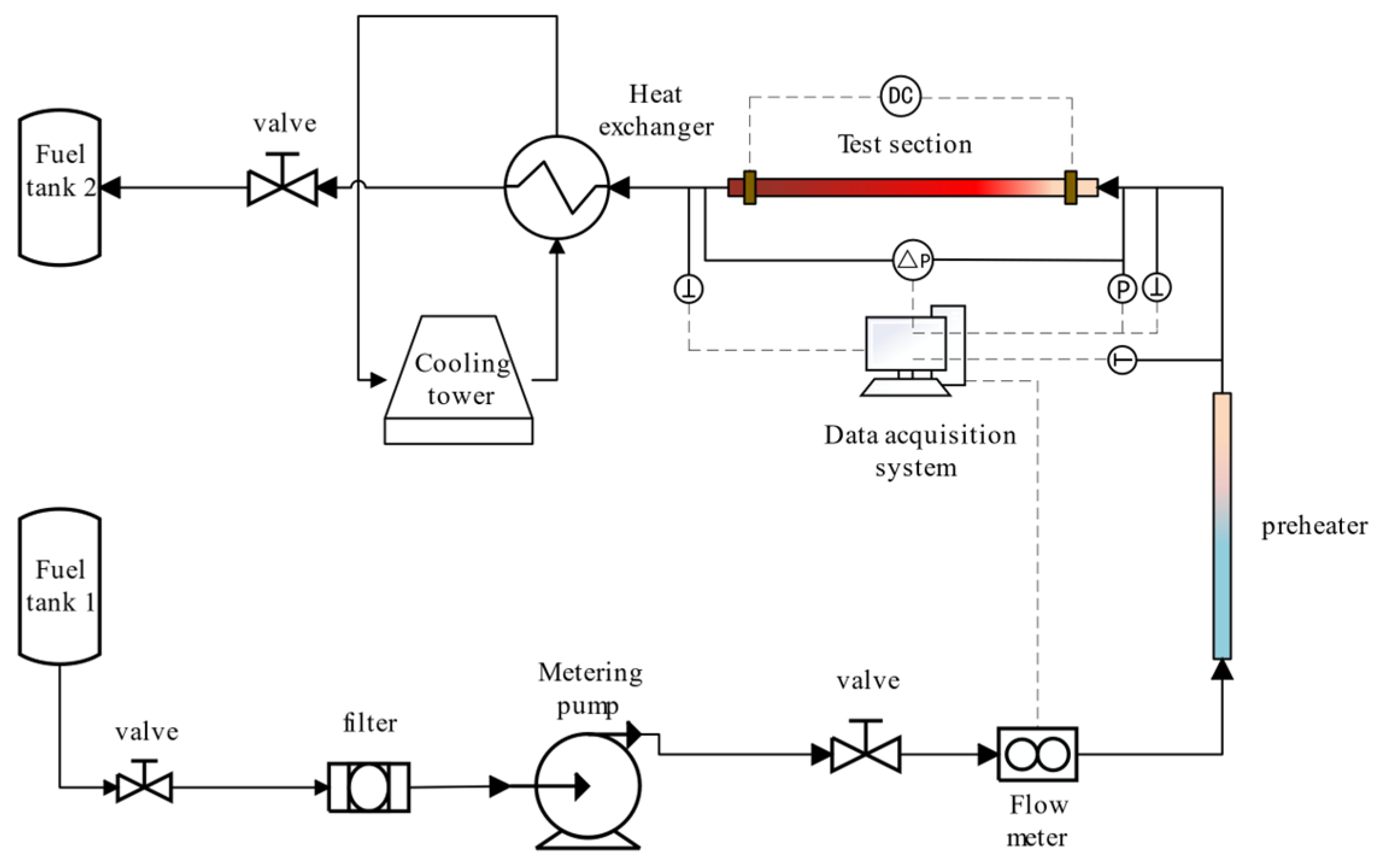
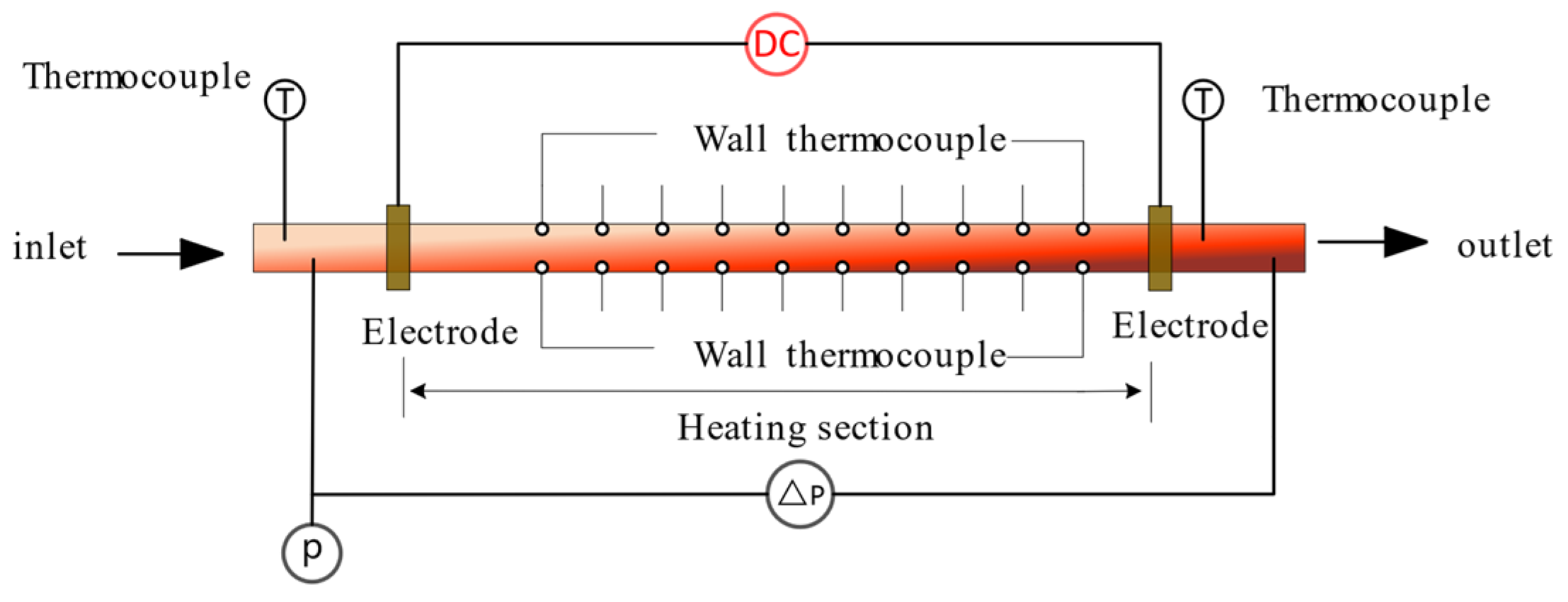

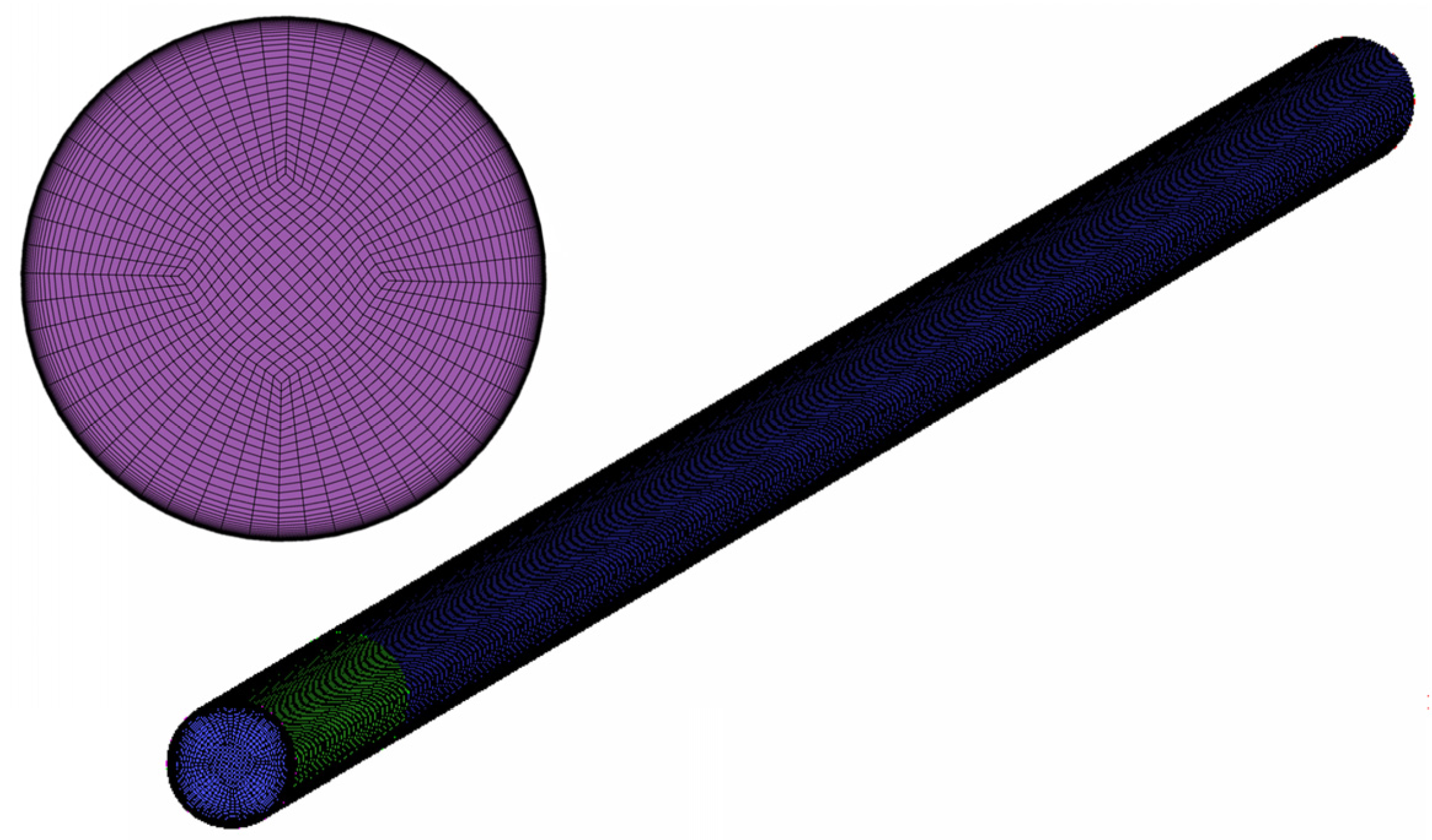
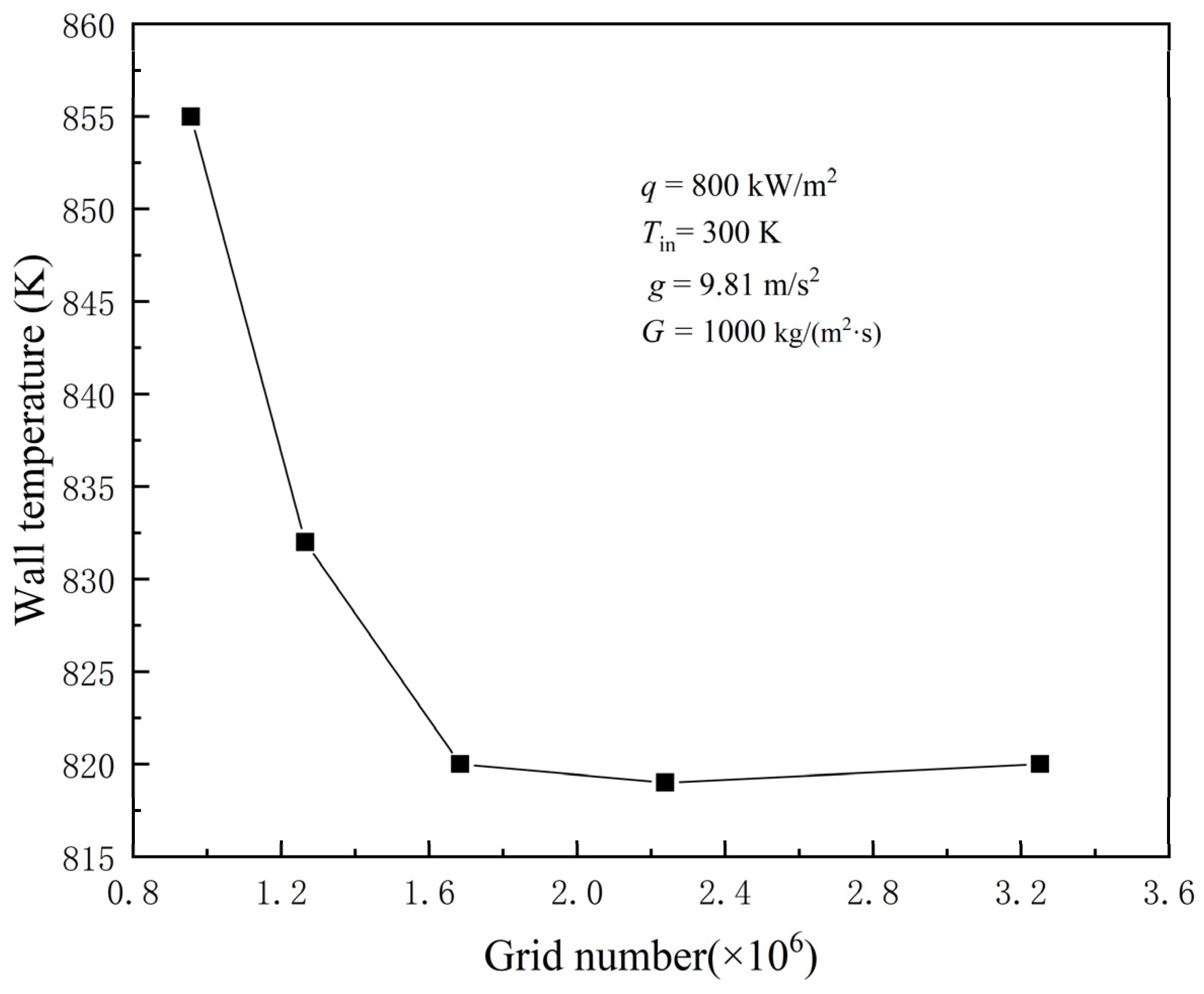



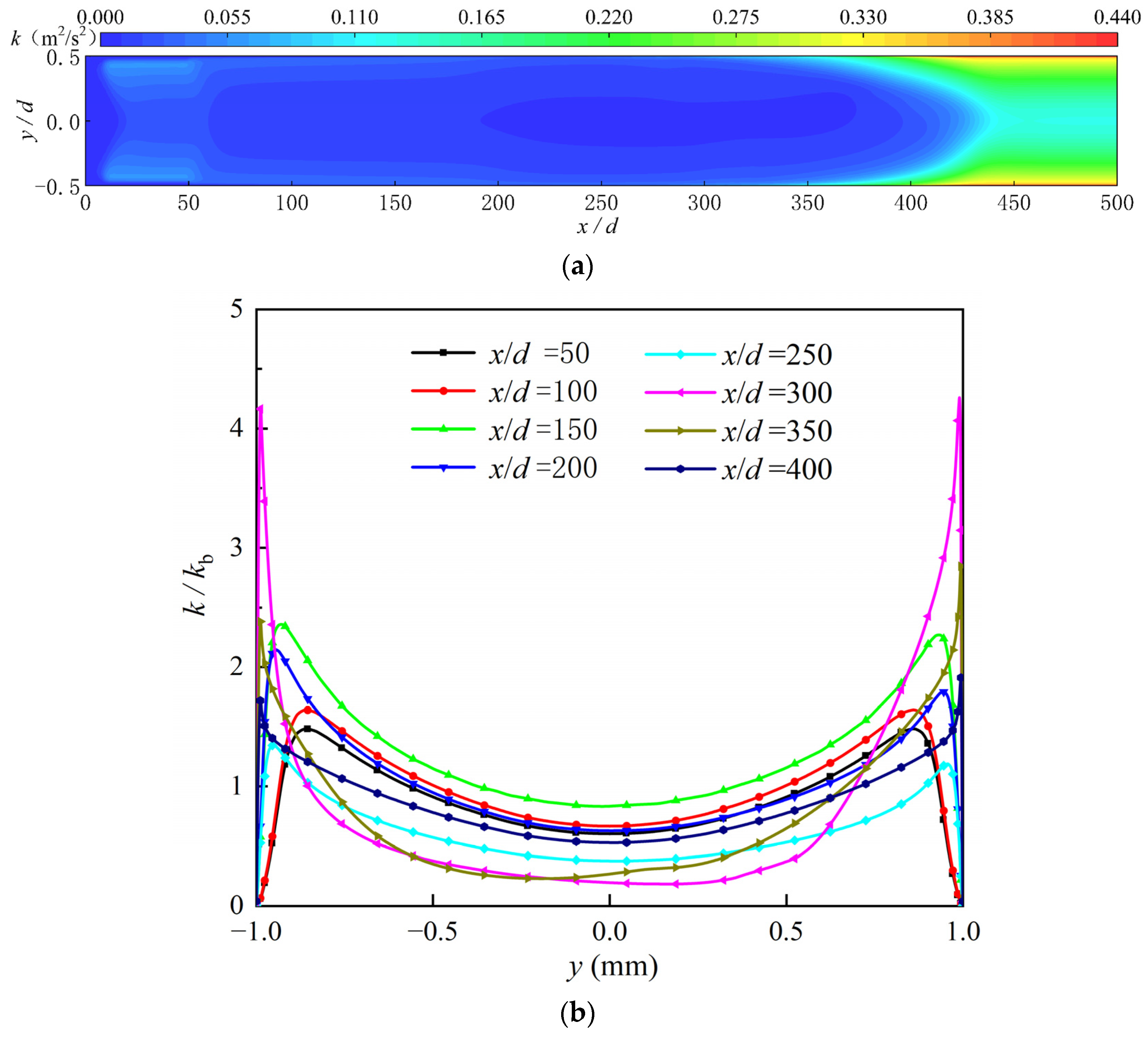
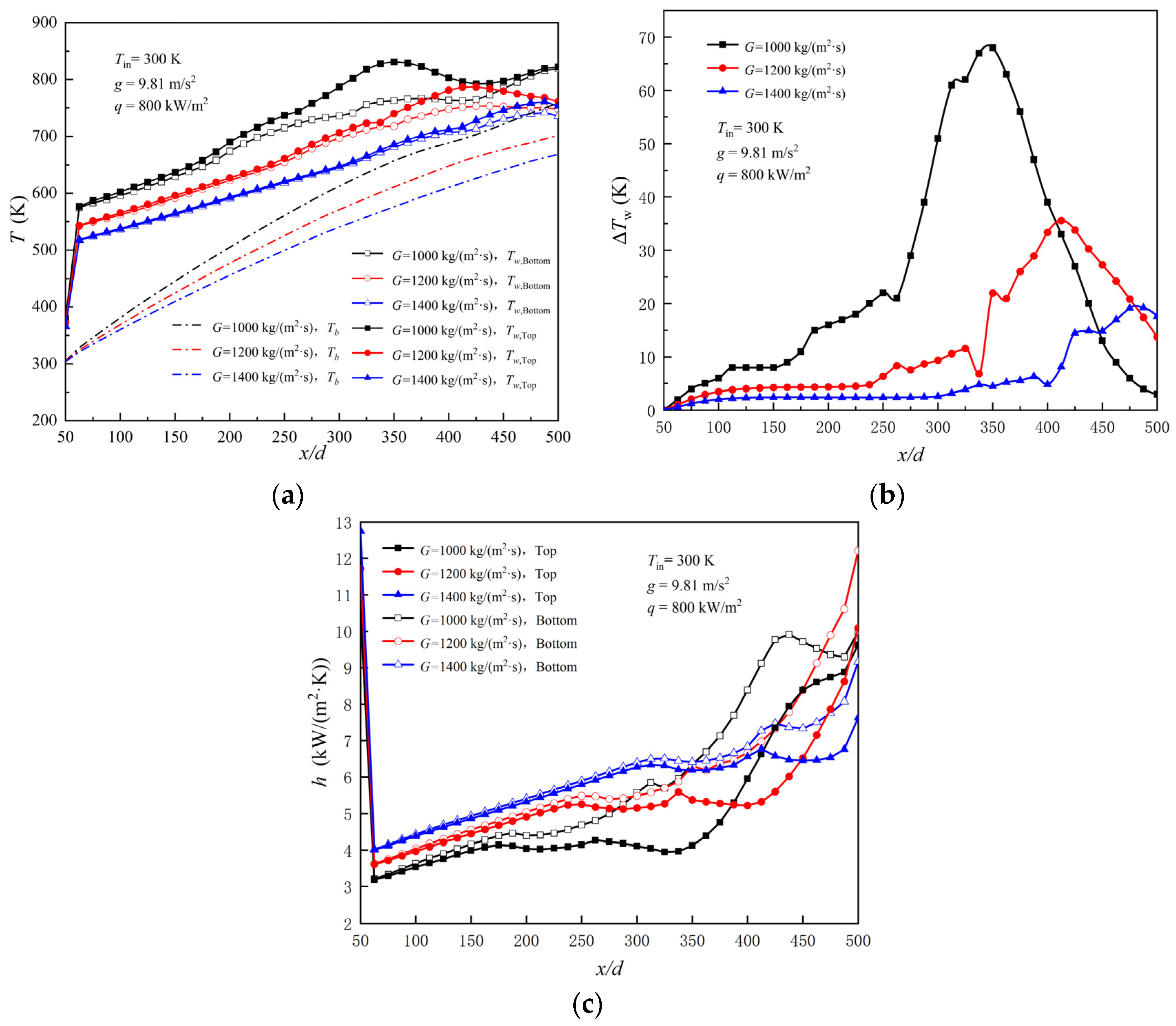

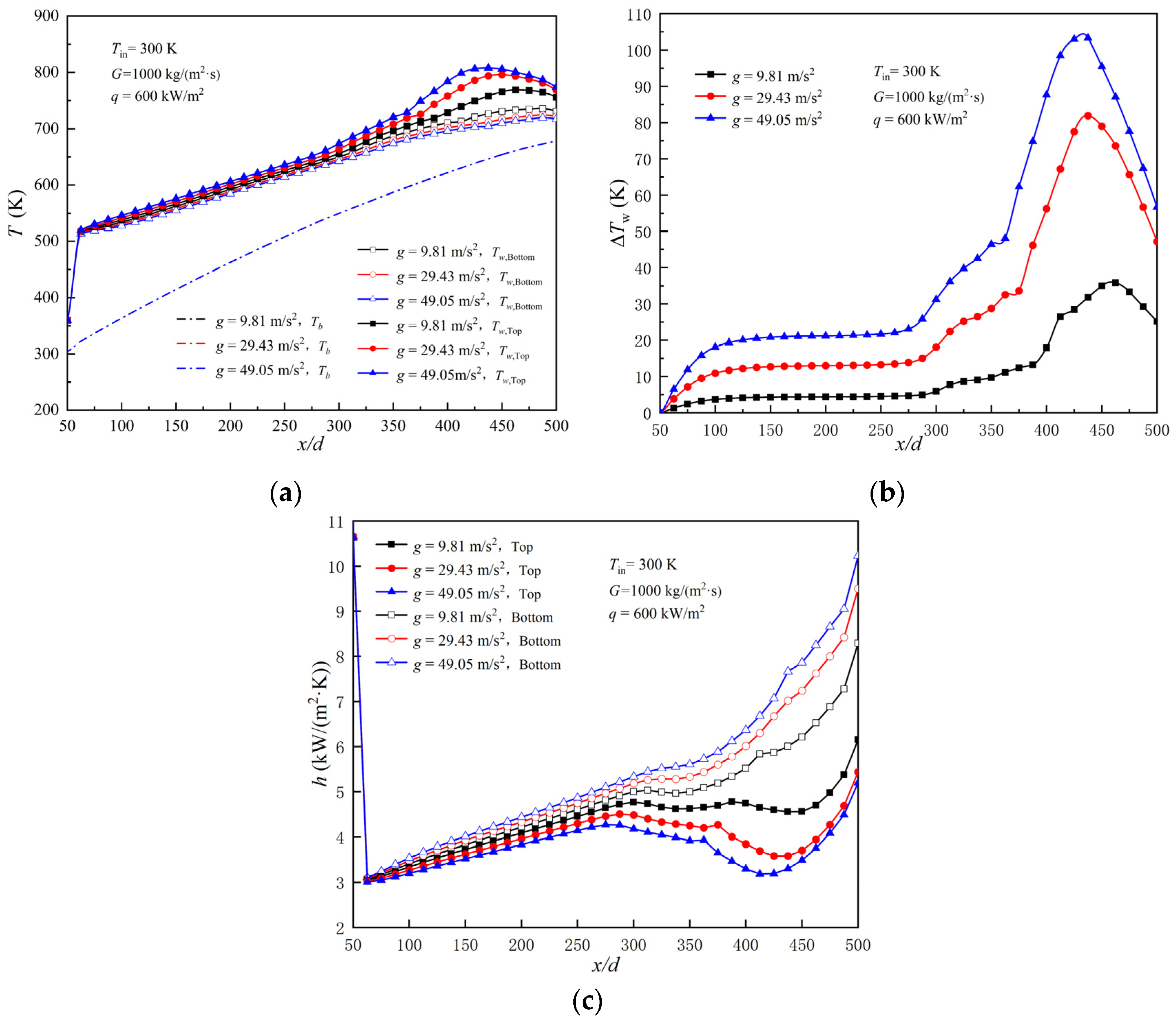

| Experimental Parameters | Uncertainties |
|---|---|
| Mass flux/kg·m−2·s−1 | 0.43% |
| Heat flux/W·m−2 | 3.03% |
| Heat-transfer coefficient/kW·m−2·K−1 | 7.64% |
| Wall temperature/K | ±0.5 K |
| Fluid temperature/K | ±0.5 K |
Disclaimer/Publisher’s Note: The statements, opinions and data contained in all publications are solely those of the individual author(s) and contributor(s) and not of MDPI and/or the editor(s). MDPI and/or the editor(s) disclaim responsibility for any injury to people or property resulting from any ideas, methods, instructions or products referred to in the content. |
© 2024 by the authors. Licensee MDPI, Basel, Switzerland. This article is an open access article distributed under the terms and conditions of the Creative Commons Attribution (CC BY) license (https://creativecommons.org/licenses/by/4.0/).
Share and Cite
Zhang, Q.; Wang, K.; Yu, Z.; Ma, H.; Huang, B. Convection Heat-Transfer Characteristics of Supercritical Pressure RP-3 in Horizontal Microchannels. Energies 2024, 17, 3247. https://doi.org/10.3390/en17133247
Zhang Q, Wang K, Yu Z, Ma H, Huang B. Convection Heat-Transfer Characteristics of Supercritical Pressure RP-3 in Horizontal Microchannels. Energies. 2024; 17(13):3247. https://doi.org/10.3390/en17133247
Chicago/Turabian StyleZhang, Qiaoling, Kangming Wang, Ziyuan Yu, Haoran Ma, and Biyun Huang. 2024. "Convection Heat-Transfer Characteristics of Supercritical Pressure RP-3 in Horizontal Microchannels" Energies 17, no. 13: 3247. https://doi.org/10.3390/en17133247
APA StyleZhang, Q., Wang, K., Yu, Z., Ma, H., & Huang, B. (2024). Convection Heat-Transfer Characteristics of Supercritical Pressure RP-3 in Horizontal Microchannels. Energies, 17(13), 3247. https://doi.org/10.3390/en17133247




